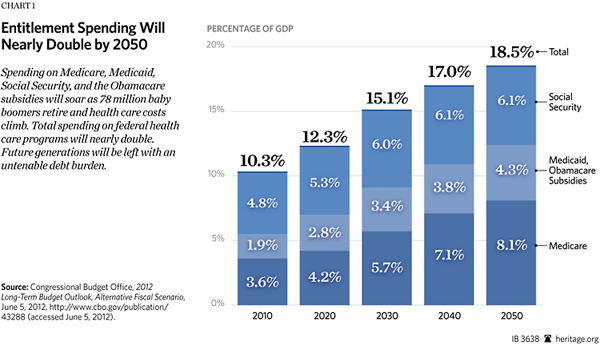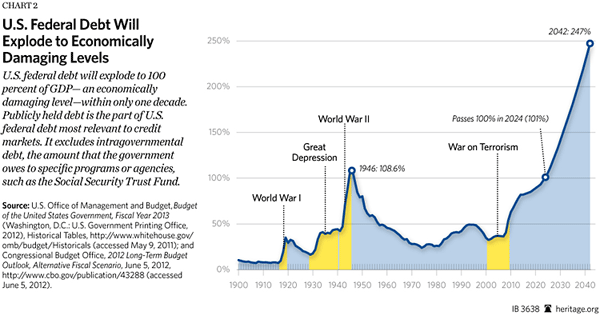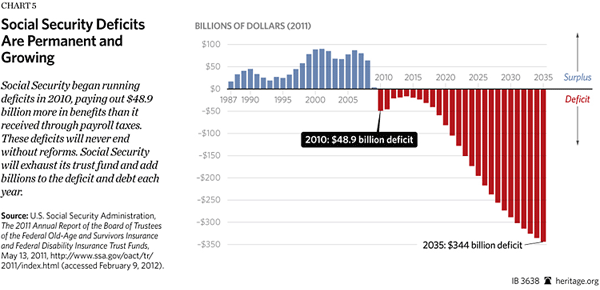The 2012 Congressional Budget Office (CBO) long-term budget outlook illustrates a grim picture for the nation’s fiscal future unless entitlements are reformed. In particular, spending on Medicare and Social Security is the largest driver of federal spending and debt. In combination with the 2012 trustees report, the projections in this latest CBO report present a compelling case to reform these entitlements now—before a European-style fiscal crisis forces needlessly painful policy changes on Americans.
Unsustainable Growth in Federal Spending, Debt
CBO predicts that spending on entitlements—Medicare, Medicaid, and Social Security—will grow from 10 percent of gross domestic product (GDP) today to a staggering 18.5 percent of GDP by mid-century.
By that time, U.S. publicly held debt would soar well beyond 250 percent of GDP. Many economists agree that economic growth is materially slowed when debt approaches the size of the economy. With debt at two-and-a-half times the size of the economy, the economic consequences would be devastating.
This unsustainable growth in spending and debt would also cause net interest costs on the U.S. federal debt to spiral to unbearable levels. CBO predicts that net interest costs will increase nearly sevenfold, surging from 1.4 percent of GDP today to 9.5 percent in 2037. This is particularly troubling as net interest costs already exceed spending for many government programs. By 2037, net interest costs—just the interest on the publicly held debt—would nearly equal spending on all discretionary programs, including national defense and education.
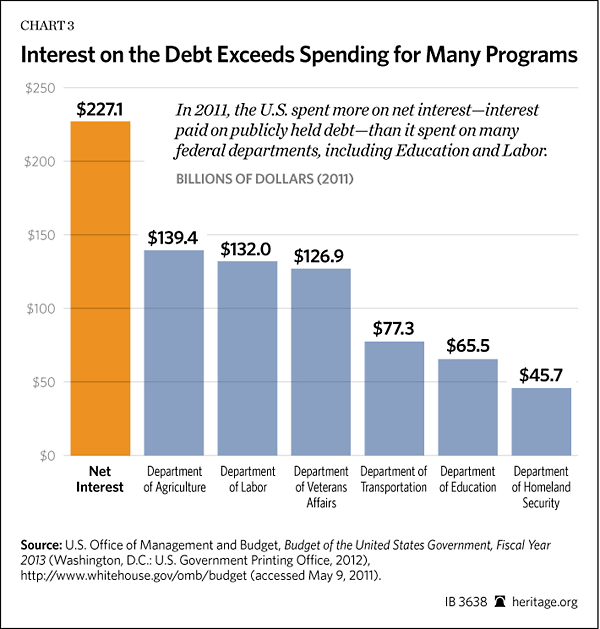
Medicare at Risk
The central fiscal challenge facing Medicare is the dramatic growth in its spending and debt. Demographic changes and rising health care costs have put Medicare on a path to crisis. Reform should be imminent if the federal health care program is to be affordable and fiscally sustainable in the future.
According to the 2012 trustees report,[1] Medicare Part A—the Hospital Insurance, or HI program, financed almost entirely by payroll taxes—will be insolvent starting in 2024. This insolvency date would have moved forward by one year to 2023 had it not been for Medicare cuts put in place in 2011 through the Budget Control Act sequestration that totaled almost $100 billion over the next 10 years.[2] Part A has spent more than it has taken in through payroll taxes since 2008, and these cash deficits will continue well into the future.
Under current-law projections, Medicare’s unfunded obligation (net present value)[3] to pay promised benefits over the 75-year period is approximately $26.9 trillion. The more realistic assessment by the Medicare actuary, however, has projected the unfunded obligation to be about $10 trillion higher at approximately $36.9 trillion.
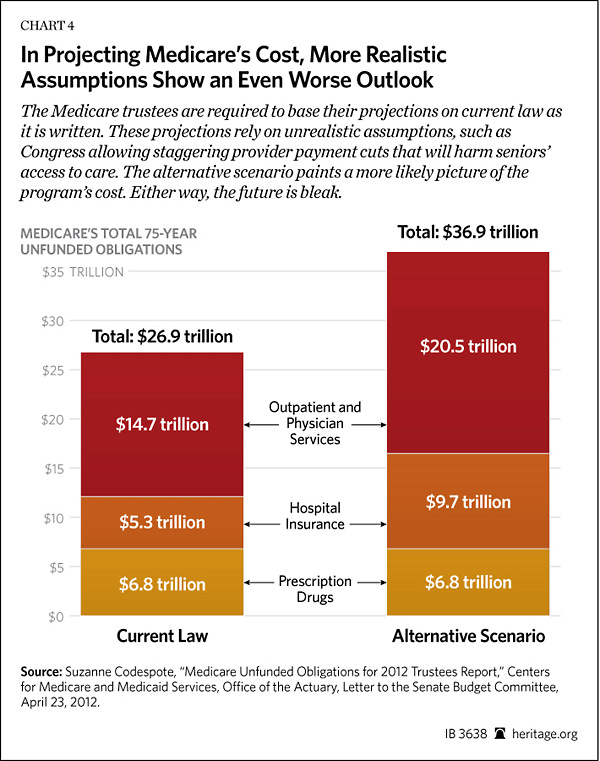
The vast gap between the two estimates of Medicare’s long-term fiscal challenge result from a difference in policy scenarios. The Medicare actuaries take into account that some policies included in the trustees’ estimate are unlikely to occur. For example, the Sustainable Growth Rate (SGR) is scheduled to cut Medicare physician payments by 30 percent in 2013. However, Congress has overridden the implementation of the SGR every year since 2002. Similarly, the actuaries’ alternative report assumes that cuts from Obamacare are unattainable and will not be fully implemented. It therefore projects that Medicare spending will surpass 10 percent of GDP, at which point it will devour more than half of all federal tax revenue. The status quo is unsustainable and, if maintained, guarantees a Medicare crisis in the not-so-distant future.[4]
Social Security Benefit Cuts on the Horizon
Social Security’s deficits are permanent and growing. Unless the program is reformed, everyone receiving Social Security benefits faces a benefit cut of about 25 percent as soon as 2033.
Social Security began running deficits in 2010. That year, the program spent $49 billion more in benefits than it took in from its payroll tax. In 2011, Social Security incurred a $45 billion deficit. According to the 2012 trustees report,[5] the expected average annual gap between Social Security spending and the program’s payroll tax revenue is $66 billion between 2012 and 2018.
The amount of money Congress would have to invest today to pay for Social Security’s promised benefits over the 75-year long-term horizon is $11.3 trillion (net present value). This figure is the difference between what Social Security owes in benefits and what it will receive in taxes.[6]
Saving the American Dream with Entitlement Reform
By all measures, Medicare and Social Security are on a path of perpetual deficits and debt. Successful reform would make these major federal entitlements more effective, efficient, affordable, and fiscally sustainable in the long run. As these are the major drivers of overall federal spending and debt, Medicare and Social Security reform would further improve the prospects for robust economic growth.
Scaling back benefits for the most affluent seniors and focusing help on those who truly need it first would strengthen and preserve Medicare and Social Security. This is already a tried and true bipartisan solution for Medicare.[7] The Heritage Foundation’s Saving the American Dream plan lays out how to implement these entitlement reforms, along with other budget and tax reforms, to ensure long-term prosperity for current and future generations.[8]
Romina Boccia is Research Coordinator in the Thomas A. Roe Institute for Economic Policy Studies at The Heritage Foundation.
